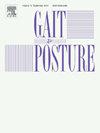关节对下肢活动范围的影响:一种探索关节功能的简单方法
IF 2.4
3区 医学
Q3 NEUROSCIENCES
引用次数: 0
摘要
本文提出了一种量化下肢功能的新方法,即探索下肢运动范围(RoMLL)的相对贡献。研究问题:关节对RoMLL的影响是否敏感,并与步态速度、关节动力学和能量学有关?方法采用三维运动捕捉技术记录行走和垂直起跳推进阶段的髋、膝关节和踝关节矢状面运动学和动力学,计算并探讨关节对RoMLL的相对贡献(RoMLL =髋关节、膝关节和踝关节RoM之和)。通过比较健康对照者与全膝关节置换术前和术后3个月行走期间患者关节对RoMLL的影响来评估敏感性。采用相关分析的方法,探讨关节对RoMLL的贡献与行走速度的关系,以及关节对RoMLL的贡献与落体跳跃推进阶段的总支撑力矩、净功率和总功的关系。结果患者在全膝关节置换术(TKR)前后行走时,膝关节对RoMLL的贡献明显小于健康对照组(p ≤ .023)。无显著相关性(rho≤0.143;p ≥ )。据报道,关节对RoMLL的贡献与步行速度之间存在相关性。在下降跳跃的推进阶段,联合贡献的RoMLL与净功率(rrm =.804)和总功(rrm =.868)之间存在显著相关性(p ≤ .004)。对RoMLL的相关关节贡献提供了一种敏感而简便的探索下肢功能的方法。本文章由计算机程序翻译,如有差异,请以英文原文为准。
Joint contributions to lower limb range of motion: A simple means of exploring joint function
Background
This paper proposes a novel means of quantifying lower limb function by exploring relative contributions to lower limb range of motion (RoMLL).
Research question
Are joint contributions to RoMLL sensitive, and associated with gait velocity and joint kinetics and energetics?
Methods
Sagittal plane hip, knee and ankle joint kinematics and kinetics, recorded using 3D motion capture, during walking and the propulsive phase of a drop vertical jump were used to calculate and explore relative joint contribution to RoMLL (RoMLL = sum hip, knee and ankle RoM). Sensitivity was assessed by comparing joint contributions to RoMLL between healthy controls and patients pre and 3-months post total knee replacement during walking. Correlation analysis was used to explore the association between joint contributions to RoMLL and walking velocity, and joint contributions to RoMLL and total support moment, net power and total work during the propulsive phase of a drop jump.
Results
Patients displayed significantly (p ≤ .023) smaller knee joint contributions to RoMLL compared to healthy controls during walking pre and post total knee replacement (TKR). No significant correlations (rho ≤.143; p ≥ .225) were reported between joint contributions to RoMLL and walking velocity. Significant (p ≤ .004) correlations were reported between joint contribution to RoMLL and net power (rrm =.804) and total work (rrm =.868) during the propulsive phase of a drop jump.
Significance
Relative joint contributions to RoMLL offer a sensitive and easy means of exploring lower limb function.
求助全文
通过发布文献求助,成功后即可免费获取论文全文。
去求助
来源期刊

Gait & posture
医学-神经科学
CiteScore
4.70
自引率
12.50%
发文量
616
审稿时长
6 months
期刊介绍:
Gait & Posture is a vehicle for the publication of up-to-date basic and clinical research on all aspects of locomotion and balance.
The topics covered include: Techniques for the measurement of gait and posture, and the standardization of results presentation; Studies of normal and pathological gait; Treatment of gait and postural abnormalities; Biomechanical and theoretical approaches to gait and posture; Mathematical models of joint and muscle mechanics; Neurological and musculoskeletal function in gait and posture; The evolution of upright posture and bipedal locomotion; Adaptations of carrying loads, walking on uneven surfaces, climbing stairs etc; spinal biomechanics only if they are directly related to gait and/or posture and are of general interest to our readers; The effect of aging and development on gait and posture; Psychological and cultural aspects of gait; Patient education.
 求助内容:
求助内容: 应助结果提醒方式:
应助结果提醒方式:


